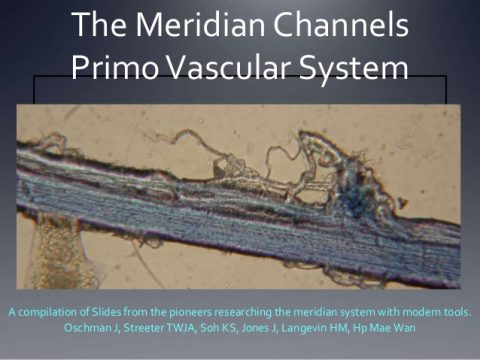
Is this a PVS structure or something else?
Acupuncture meridians and acupoints are imaginary until proven otherwise. Anatomists have have never been able to detect them by microscopy or autopsy, and they are not mentioned in anatomy textbooks. For decades, acupuncturists have been trying to prove that their pre-scientific belief system is grounded in scientific reality. Now they are telling us that acupuncture meridians and acupoints have been discovered in the form of the Primo vascular system (PVS). A typical website trumpets “Science Finally Proves Meridians Exist.”
The available information is confusing.
Primo vessels were supposedly missed by anatomists because they are so small. They are reported to only be visible by electron microscopy, yet researchers have used dye to show them under a regular microscope. There has been speculation about their involvement in cancer metastasis: one paper provides images of a putative PVS cancer metastasis thread afloat in a lymph duct. PVS vessels are said to be too tiny to study by the usual methods of science, but some researchers say they have somehow learned that they are characterized by high resistance and low capacitance. They are allegedly studded with electrically charged nodes that attract nutrients, oxygen, and regulatory hormones. They allegedly transmit energy to organs and integrate the features of the cardiovascular, nervous, immune, and hormonal systems and serve as the physical substrate for acupuncture points and meridians.
Qi is re-interpreted as an electromagnetic wave involved very closely with the DNA in the PVS. “The PVS is the communication system between living organisms and the environments, and it lies at the lowest level of life.” The PVS consists of double-coated PVs that contain multiple subvessels, and PNs, nodes that gather and distribute the PVs and control the PVS fluid’s flow speed, direction, and contents. They hypothesize that DNA in PVS microcells stores information obtained from environmental physical fields such as electromagnetic fields. There is much speculation involving biophonons, biophotons, stem cells, etc.
I tried to read and understand this information, but I failed to make sense out of it. When that happens, I can’t help but wonder whether it’s my failure or the fact that the material simply doesn’t make sense. In this case, I strongly suspect the latter. Some of the material is close to incoherent, and some of it is self-contradictory.
The history of PVS research
The PVS was discovered by a North Korean researcher named Bong-Han Kim in 1962. He originally referred to his findings as Bonghan ducts and Bonghan corpuscles, corresponding to acupuncture meridians and acupoints. He also spoke of Bonghan liquor, a liquid circulating in the Bonghan ducts that he characterized as abundant in DNA and RNA, with a nitrogen content of 3.23-3.4%, hyaluronic acid 170.4 mg%, more than 19 amino acids, and 16 free mono nucleotides. (How do you suppose he got enough liquid out of these tiny structures to analyze?) He claimed that the system is proven to exist in all animals and even in plants, and is made up of several subsystems that are interconnected to form a single coherent system. You can read a synopsis of his results here. He published five “research reports” (not formal articles in peer-reviewed journals) that apparently didn’t provide enough detail for others to replicate successfully. His laboratory in North Korea abruptly closed in 1966, and Kim disappeared. His fate is still unknown. Interest in his research later resurfaced in South Korea. Many attempts at replication failed, but in 2002 researchers in South Korea claimed they had confirmed the existence of the PVS and they continue to investigate its properties. This webpage summarizes the studies that have allegedly confirmed Kim’s results.
Why I’m skeptical
More than half a century has elapsed since these structures were first described. After all this time, they have not been accepted by mainstream anatomists. They have not found their way into textbooks and are not being taught in medical schools. Keep in mind that scientists have been using electron microscopes for decades now, and if these structures existed in all animals and even plants, they would have been hard for electron microscopists to miss. Other researchers not connected to the group in South Korea have been unable to detect the PVS. Its existence is highly questionable, but never fear: “Richard C. Niemtzow has seen it [emphasis added] at the Nano Primo Research Center, Advanced Institute of Convergence Technology under the Direction of Dr. Kwang-Sup Soh in Seoul, South Korea.” You may remember Niemtzow as the Air Force colonel who made up battlefield ear acupuncture out of thin air. Even if he were a reliable, unbiased observer, it would be foolish to simply accept his assertion that he had “seen” the PVS as proof.
The language on PVS websites is metaphysical and pseudoscientific, not the language of science. I had to laugh out loud when I read that the PVS liquid could “aggregate to form stem cells”! I don’t know what to make of the pictures that have been published showing alleged PVS structures. They could be anything. I am reminded of the pictures of rope worms. There is indeed something in the pictures, but it’s not worms.
I am also reminded of the N-rays discovered by the French physicist Blondlot in 1903. They were supposedly a new form of radiation. Researchers around the world jumped on the N-ray bandwagon: in short order, over 300 published articles confirmed Blondlot’s findings. But other physicists were unable to reproduce the findings. The journal Nature sent in Robert W. Wood to investigate. He surreptitiously rendered the N-ray detection device inoperable by removing the prism, and the rays were still detected. When Blondlot’s assistant caught Wood replacing the prism, he assumed he was removing it, so the next experiment (with the device fully operable) found no N-rays. N-rays were demonstrated to be nothing but illusion and self-deception. Those 300 published studies were all wrong.
Anyway, PVS doesn’t validate acupuncture
In the first place, since acupuncture has not been shown to work (except as a theatrical placebo), the whole enterprise of trying to find out how it works amounts to chasing after moonbeams.
Even if the PVS were accepted by mainstream science, that would not mean its structures were acupuncture meridians and acupoints. In fact, the structures are reported to be ubiquitous, not limited to traditional meridian locations. And how could the insertion of acupuncture needles affect the PVS to relieve pain and affect human health? If the structures are so tiny, how could you even hope to find them with a needle? And what would all this mean for the many systems of acupuncture that have nothing to do with the traditional meridians, like ear acupuncture and Korean hand acupuncture?
Conclusion: N-rays with needles
I don’t know whether the structures described as the PVS exist. If they are real, we should be seeing some better evidence soon. I’ll stick my neck out and bet my two cents that they are not real; I suspect they are as illusory as the infamous N-rays. But even if they were real, they wouldn’t begin to prove that acupuncture works.






